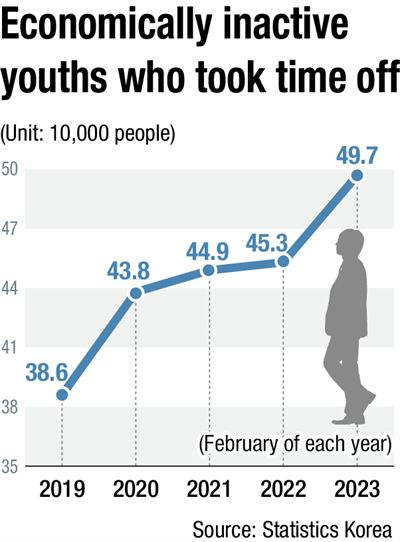

登錄


登錄
海擇短評 Haize Comment:
後疫情期各國通膨失衡、經濟減速,但讓人意外的是,通膨起源地美國的失業率尚未高漲,太平洋另一端的韓國,未從事經濟活動的青年人數卻已創下歷史新高。
根據韓國統計資訊服務(KOSIS, KOrean Statistical Information Service)數據,今年2月年齡介於15歲至29歲的人口,有49.7萬人未從事經濟活動(Economically Inactive),該數據創下統計局自2003年收錄該數據以來的歷史新高,YoY成長9.9%,比2019年疫情前同期成長28.8%。
根據韓國統計局定義,未從事經濟活動(Economically Inactive)與失業在定義上的差異是,前者為15歲以上既沒有就業也沒有失業的人,而失業指的是在過去四個星期內曾嘗試就業但失敗的人。未從事經濟活動的群體,又可細分為從事育兒、家務、受教育或因年老、身體或精神殘疾等其他原因無法工作的人。在統計局於去年8月公布的數據中,共有超過半數的未從事經濟活動群體屬於其他原因,其中39.4%為健康狀況不佳,18.1%為很難找到想要的工作。
單從韓國2月的青年就業人數385.0萬人來看,有49.7萬人未從事經濟活動,其實看不出失業事態是否嚴重。因為按照國際勞工組織(ILO, International Labour Organization)的標準,失業者定義必須同時符合"沒有工作"、"隨時可以開始工作"、"正在找工作或已找工作正在等待結果"3項條件;而韓國統計局認為用"未從事經濟活動"這個數據更能反映真實的原因是,大學畢業生中放棄找工作的比例非常高,比如按照韓國工業聯合會(FKI, Federation of Korean Industries)調查,2022年3月畢業的大學畢業生中有近70%放棄找工作,如果用失業的定義來計算,失業率反而下降。
無論哪一種數據更符合真實,青年未從事經濟活動的人數創新高總是個警訊,這也是後疫情時期東亞國家可能都正在面臨的新態勢。
----------
The post-pandemic period has seen an imbalance in inflation and a slowdown in the economies of various countries, but surprisingly, while the unemployment rate in the United States, where the inflation originated, has not yet risen, the number of economically inactive young people on the other side of the Pacific Ocean in Korea has reached a record high.
According to KOSIS (Korean Statistical Information Service), 497,000 people aged between 15 and 29 were Economically Inactive in February, a record high since the statistics office collected the data in 2003, a growth of 9.9% YoY, up 28.8% from the same period in 2019 (pre-pandemic).
According to Statistics Korea, the difference between Economically Inactive and Unemployed is that the former refers to person over the age of 15 who is neither employed nor unemployed, while Unemployed refers to person who has sought employment but failed in the past four weeks. This economically inactive group is divided further into subcategories, such as those who are engaged in child-rearing, housework and education or those who could not work due to old age, physical or mental disabilities, as well as for other reasons. In data released last August, 39.4 percent of respondents cited poor health as the reason for their inactivity, while 18.1 percent said it was difficult to find the jobs they wanted.
Regarding the 3.850 million young people employed in Korea in February and Economically Inactive of 497,000 people, it is not clear whether unemployment is serious. According to the International Labor Organization (ILO), the definition of the unemployed must meet the three criteria of "without a job", "available to start a job", and "looking for a job or waiting for the result". However, Statistics Korea believes that the data of "economically inactive" can better reflect the reality, because the proportion of college graduates who give up looking for a job is very high. For example, according to the survey of the FKI (Federation of Korean Industries), nearly 70% of college graduates graduating in March 2022 have given up looking for a job. If we adopt the definition of unemployment, the unemployment rate is decreasing.
Regardless of which figure is more realistic, the record number of economically inactive youth is a warning, and it is a new trend that all East Asian countries may be facing in the post-pandemic period.
----------
포스트 코로나 시기에 각국의 인플레이션이 심화되고 경제 성장이 둔화되었다. 놀랍게도 인플레이션의 기원지인 미국에서는 실업률이 아직 상승하지 않고 있다. 그러나 태평양 건너 한국에서는 경제활동을 하지 않는 젊은 이들이 역대 최고 수준이다.
국가통계포털(KOSIS)에 따르면 2월에 15∼29세 비경제활동(Economically Inactive)인구는 49만7,000명으로 전년 동기대비 9.9%, 2019년보다 28.8% 증가해 2003년 통계 집계 이후의 최고치를 기록했다.
통계청에 따르면 '비경제활동'과 '실업'의 정의상 차이는 '비경제활동'은 만 15세가 넘은 인구 가운데 취업자도 실업자도 아닌 사람을 뜻한다. '실업'은 지난 4주 동안 일자리를 찾았지만 성공하지 못한 사람을 말한다. '비경제활동' 의 군체는 또 진일보 몇가지로 나뉜다. 예를 들어, 육아, 가사에 종사하는 사람 및 교육을 받고 있는 사람, 또는 연로, 신체적 또는 정신적 장애 및 기타 이유로 일할 수 없는 사람이다. 지난해 8월 발표된 자료에 따르면 반수 이상의 '비경제활동'인구는 다른 이유 때문이다. 이 중 39.4%는 건강이 좋지 않았기 때문이었고, 18.1%는 원하는 직장을 구하기 어려웠다고 답했다.
2월 국내 청년 취업자 수는 385만명, 비경제활동인구는 49만7,000명이었다. 하지만 이 수치로는 사실 실업 상황이 심각한지 확인할 수 없다. 국제노동기구(ILO)의 정의에 따르면 실업자는 '일자리가 없다', '언제든 일을 시작할 수 있다', '일자리를 찾고 있거나 이미 일자리를 찾았을 뿐 채용 결과를 기다리고 있다'는 세 가지 기준을 충족해야 한다. 그러나 통계청은 '비경제활동'의 수치가 현실을 더 잘 반영한다고 보고 있다. 대졸자가 취직을 포기하는 비율이 높기 때문이다. 예로 들어 전국경제인연합회(FKI) 조사에 따르면 2022년 3월 졸업한 대졸자의 70% 가까이가 취직을 포기했다. 만약 실업의 정의를 채택하여 계산한다면, 실업률은 확실히 떨어진 사실이다.
어느 숫자가 더 현실에 부합하든 경제활동에 종사하지 않는 청년 수가 기록을 세우는 것은 경고다. 이는 포스트 코로나 시대에 모든 동아시아 국가들이 직면할 새로운 추세다.

資料來源 Resource:KoreaTimes
標籤 Label:South Korea unemployment economically inactive post-pandemic